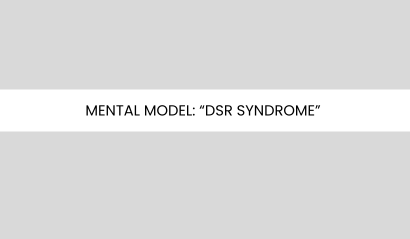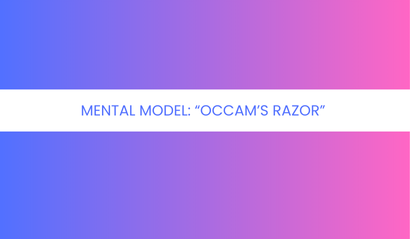Mental Model: Association Bias
The human brain is wired to recognize patterns and make connections between concepts, people, and experiences. This ability helps us navigate daily life efficiently. However, sometimes, these connections are misleading or based on superficial associations rather than factual evidence. This is where association bias comes into play.
Association bias is a cognitive bias that causes people to link unrelated events, characteristics, or groups based on perceived but often misleading connections. These biases can lead to stereotyping, faulty decision-making, and unfair judgments. Understanding association bias is crucial in both personal and professional settings, as it influences everything from hiring practices to consumer behavior.
This blog explores the origins of association bias, explains how it works, provides real-life examples, and outlines strategies to mitigate its effects.
The Origins of Association Bias
Association bias is rooted in cognitive heuristics, which are mental shortcuts the brain uses to process information quickly. These heuristics developed as evolutionary advantages, allowing humans to react swiftly to their environment. However, while they are efficient, they are not always accurate.
One of the primary heuristics responsible for association bias is the representativeness heuristic, which leads people to judge probabilities based on how similar something appears to a known category rather than on statistical logic. Another factor is confirmation bias, where individuals favor information that supports their pre-existing beliefs while ignoring contradictory evidence.
Association bias is also influenced by social conditioning and cultural reinforcement. Media portrayals, societal norms, and personal experiences shape our unconscious associations, often reinforcing stereotypes and prejudices.
How Association Bias Works
At its core, association bias occurs when people make automatic mental connections between two things based on superficial similarities rather than objective reasoning. These associations may stem from prior experiences, cultural influences, or misleading representations.
For example, if someone repeatedly hears about financial scams involving people of a particular nationality, they may begin to associate that nationality with dishonesty, despite having no statistical basis for such a belief. This biased perception can lead to discrimination and flawed decision-making.
Key Cognitive Mechanisms Behind Association Bias:
- Pattern Recognition – The brain looks for patterns even when none exist, often leading to false connections.
- Availability Heuristic – People rely on readily available information to make judgments, even if that information is biased or incomplete.
- Social Reinforcement – When certain stereotypes are repeatedly reinforced by peers or media, they become ingrained.
- Emotional Conditioning – Negative or positive emotions associated with past experiences can influence current perceptions unfairly.
Examples of Association Bias in Everyday Life
1. Hiring and Workplace Bias
Recruiters and hiring managers may unconsciously associate certain traits with competence based on superficial characteristics like ethnicity, gender, or educational background. For instance, a hiring manager may assume that a candidate from an Ivy League school is more capable than one from a lesser-known institution, even if the latter has superior skills and experience.
2. Consumer Behavior and Branding
Marketers leverage association bias to influence consumer preferences. For example, people often associate Apple products with innovation and prestige, even if other brands offer comparable technology. This is due to effective branding and repeated exposure to positive associations.
Similarly, negative brand associations can hurt businesses. A single PR disaster can create lasting negative perceptions that influence consumer choices long after the actual event.
3. Racial and Gender Stereotypes
Association bias is a significant contributor to racism and sexism. If people repeatedly see certain racial or gender groups portrayed in specific roles (e.g., women as caregivers, men as leaders), they unconsciously associate those roles with those groups. This can impact career opportunities, social interactions, and policy-making.
4. Health and Medicine
Association bias can also be found in healthcare, where doctors may associate certain symptoms more with one demographic than another, leading to misdiagnosis. For instance, studies have shown that women’s heart attack symptoms are often dismissed because heart disease is more commonly associated with men.
5. Financial and Investment Decisions
Investors may fall prey to association bias by linking past trends with future outcomes without factual basis. For example, if a particular stock performed well in the past under a certain CEO, investors may assume it will continue to perform well under similar conditions, ignoring other critical factors.
The Impact of Association Bias
Association bias can have serious consequences, including:
- Unfair Discrimination – Leads to workplace bias, racial profiling, and stereotyping.
- Poor Decision-Making – Influences hiring, marketing, and investment choices based on misleading associations.
- Reinforcement of Stereotypes – Media and social narratives perpetuate certain biases, making them harder to dismantle.
- Erosion of Trust – Biased judgments can damage relationships, whether in business, politics, or personal life.
How to Avoid Association Bias
Although association bias is deeply ingrained, individuals and organizations can take proactive steps to mitigate its effects.
1. Awareness and Education
Recognizing that association bias exists is the first step. Organizations should provide bias training to employees, especially those in decision-making roles, to help them understand and counteract their own unconscious biases.
2. Fact-Checking and Data Analysis
Before forming opinions or making decisions, individuals should seek objective data rather than relying on gut instincts or anecdotal evidence. For example, hiring managers should focus on skills and experience rather than perceived prestige.
3. Exposure to Diversity
Interacting with people from different backgrounds helps break down stereotypes. Studies show that increased exposure to diversity reduces unconscious biases and fosters more accurate perceptions.
4. Structured Decision-Making
Implementing standardized evaluation criteria in hiring, promotions, and performance assessments minimizes the influence of unconscious bias.
5. Critical Thinking and Self-Reflection
Actively questioning one’s own assumptions and challenging mental shortcuts can help reduce bias. Ask yourself:
- Why do I associate these two things?
- Is my judgment based on evidence or just familiarity?
- Could an alternative explanation exist?
6. Using Technology to Counter Bias
AI-powered tools can help identify and reduce bias in hiring, lending, and other areas where decision-making needs to be impartial. However, these tools must be designed carefully to avoid reinforcing existing biases.
Conclusion
Association bias is an inherent part of human cognition, but it doesn’t have to dictate our decisions. By understanding its origins, recognizing its impact, and taking deliberate steps to counteract it, we can make fairer, more rational choices in both our personal and professional lives.
Whether in hiring, marketing, social interactions, or healthcare, being mindful of association bias helps build a more just and equitable society. With awareness, education, and structured decision-making, we can move beyond misleading associations and embrace a more nuanced, data-driven approach to judgment and decision-making.
By actively challenging our biases, we take a step toward a world where people and ideas are judged on their merit, not on misleading mental shortcuts.







